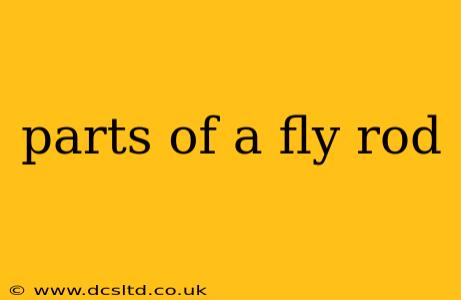Fly fishing, a sport steeped in tradition and requiring precision, relies heavily on the specialized equipment used. Understanding the various parts of a fly rod is crucial for both beginners and seasoned anglers, impacting casting performance, durability, and overall fishing experience. This detailed guide explores each component, explaining its function and significance.
What are the Main Parts of a Fly Rod?
A fly rod, unlike its spinning or baitcasting counterparts, boasts a unique construction. While the specific names and minor details might vary slightly between manufacturers, the fundamental components remain consistent. These key parts include:
-
Tip Top: This small, ceramic ring located at the very end of the rod guides the fly line smoothly as it's cast. Its smooth surface minimizes friction and prevents the line from snagging. Damage to the tip top can significantly affect casting performance.
-
Guides: These rings, typically made of hard ceramic or metal, are spaced along the rod's blank. They channel the fly line, reducing friction and allowing for effortless casting. The spacing and size of the guides are critical for efficient line flow.
-
Rod Blank: This is the core of the fly rod, the long, slender shaft made from graphite, fiberglass, or a composite material. The blank's flexibility and action (how it bends) significantly impact casting style and feel. It is the most important element impacting the rod's performance.
-
Ferrule(s): These are the connecting sections joining different rod sections together. Typically made of metal or composite materials, ferrules ensure a secure connection while minimizing gaps that could impair performance. Many rods are made in multiple pieces (two or four) for easier transport and storage.
-
Handle/Grip: This is the section you hold while casting and fishing. It's usually made of cork, rubber, or other materials providing comfort and a secure grip, even when wet. The handle design can vary dramatically impacting the feel of the rod.
-
Reel Seat: This is the part of the rod where the reel attaches. The reel seat's design and material can vary, but it must securely hold the reel in place, allowing for smooth retrieval and casting.
-
Butt Section: This is the thickest part of the rod, usually located closest to the handle, offering increased strength and stability.
What is the action of a fly rod?
H2: What is the action of a fly rod? The action of a fly rod refers to how much and where the rod bends under load. Different actions suit different fishing styles and techniques.
-
Fast Action: Bends primarily in the upper third of the rod. Provides a powerful, accurate cast with less flex, ideal for long distances and precise presentations.
-
Medium Action: Bends along a larger portion of the blank (roughly the upper half). Offers a balance between power and finesse, making it versatile for various situations.
-
Slow Action: Bends significantly along a majority of the rod's length. Provides a softer, more forgiving cast, ideal for delicate presentations and smaller flies.
What materials are fly rods made of?
H2: What materials are fly rods made of? The vast majority of modern fly rods are constructed from graphite composite materials, offering a combination of lightness, strength, and responsiveness. Fiberglass rods are still used, providing a softer, more forgiving action, often preferred by beginners. Bamboo rods represent a traditional option and are known for their exquisite craftsmanship and unique casting feel, but are less prevalent now.
How many pieces does a fly rod have?
H2: How many pieces does a fly rod have? Fly rods are commonly available in two, four, or even more pieces. The number of pieces influences portability and storage. Two-piece rods are great for easier transport, while four-piece rods excel in portability, particularly for travel.
How do I choose the right fly rod?
H2: How do I choose the right fly rod? Selecting the right fly rod depends on several factors including:
-
Fishing Style: What type of fish are you targeting, and what techniques will you be using?
-
Line Weight: This determines the rod's power and casting capability.
-
Rod Length: Longer rods provide more distance, while shorter rods offer better maneuverability in tight spaces.
-
Action: Consider the balance between power, accuracy, and finesse.
-
Budget: Fly rods range significantly in price, reflecting quality, materials, and craftsmanship.
By understanding the individual components and how they interact, anglers can appreciate the nuanced design and engineering that goes into creating a high-performance fly rod. This knowledge not only enhances the fishing experience but also aids in selecting and maintaining the proper equipment for optimum performance on the water.
